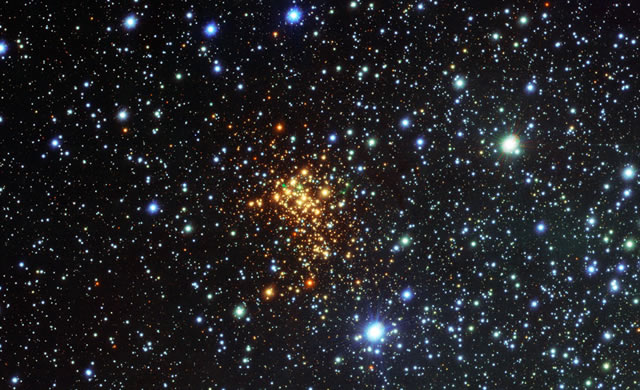
Questa nuova immagine, ottenuta usando il Telescopio per Survey del VLT (VST) all’osservatorio del Paranal di ESO, mostra il notevole super ammasso di stelle Westerlund 1 (eso1034). Quest’ammasso eccezionalmente brillante si trova a 16’000 anni-luce dalla Terra, nella costellazione di Ara (L’altare), nell’emisfero sud. Esso contiene centinaia di stelle molto massicce e brillanti, tutte dell’età di solamente qualche milione di anni – delle neonate per gli standard stellari. La nostra visione di quest’ammasso è però ostacolata dal gas e dalla polvere che impedisce alla maggior parte della luce visibile proveniente dalle stelle dell’ammasso di arrivare sulla Terra. Attualmente, gli astronomi che studiano le immagini di Westerlund 1 provenienti da una nuova survey del cielo australe hanno notato qualche cosa di inaspettato in quest’ammasso.
Attorno ad una di queste stelle – nota come W26, una supergigante rossa e possibilmente la più grande stella conosciuta – hanno scoperto delle nubi luminescenti di idrogeno gassoso, mostrate in verde in quest’immagine. Tali nubi luminescenti attorno a stelle massiccio sono molto rare, e ancora di più lo sono attorno a supergiganti rosse – questo è il primo caso di nebulosa ionizzata scoperta attorno una tale stella. W26 stessa sarebbe troppo fredda per fare risplendere il gas; gli astronomi ipotizzano che la sorgente della radiazione ionizzante possa essere costituita o da stelle blu calde situate in qualche altra parte dell’ammasso, o, in alternativa, da una compagna di W26, più debole ma molto più calda. W26 esploderà alla fine come una supernova. La nebulosa che la circonda è molto simile alla nebulosa attorno a SN1987A, i resti di una stella che divenne una supernova nel 1987. SN 1987A è la supernova più vicina alla Terra mai osservata dal 1604 e, in quanto tale, ha dato la possibilità agli astronomi di esplorare le proprietà di queste esplosioni. Lo studio di oggetti simili a questa nuova nebulosa attorno a W26 aiuterà gli astronomi a capire i processi di perdita di massa attorno alle stelle massicce, processi che portano alla loro esplosione finale.
This new picture from the VLT Survey Telescope (VST) at ESO’s Paranal Observatory shows the remarkable super star cluster Westerlund 1 (eso1034). This exceptionally bright cluster lies about 16 000 light-years from Earth in the southern constellation of Ara (The Altar). It contains hundreds of very massive and brilliant stars, all of which are just a few million years old — babies by stellar standards. But our view of this cluster is hampered by gas and dust that prevents most of the visible light from the cluster’s stars from getting to Earth. Now, astronomers studying images of Westerlund 1 from a new survey of the southern skies have spotted something unexpected in this cluster.
Around one of the stars — known as W26, a red supergiant and possibly the biggest star known— they have discovered clouds of glowing hydrogen gas, shown as green features in this new image. Such glowing clouds around massive stars are very rare, and are even rarer around a red supergiant— this is the first ionised nebula discovered around such a star. W26 itself would be too cool to make the gas glow; the astronomers speculate that the source of the ionising radiation may be either hot blue stars elsewhere in the cluster, or possibly a fainter, but much hotter, companion star to W26. W26 will eventually explode as a supernova. The nebula that surrounds it is very similar to the nebula surrounding SN1987A, the remnants of a star that went supernova in 1987. SN1987A was the closest observed supernova to Earth since 1604, and as such it gave astronomers a chance to explore the properties of these explosions. Studying objects like this new nebula around W26 will help astronomers to understand the mass loss processes around these massive stars, which eventually lead to their explosive demise.
Source/Continue reading → ESO.org





















